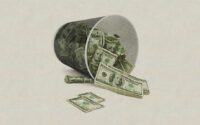Five Intriguing Error Coins Collectors Still Search For Today
Minted from 1913 through 1938, the imposing and memorable coin designed by James Earle Fraser features a handsome Native American on the obverse and a bison on the reverse. It is believed the “Black Diamond” buffalo in New York’s Central Park Zoo served as the inspiration for the coin’s reverse.
In 1937, the Denver Mint produced 17,826,000 of these legendary nickels composed of 75% copper and 25% nickel. That year, a Denver Mint employee named Mr. Young, took his job quite seriously. He over-polished the reverse die with an emery board in an effort to remove clash marks. The result of the excessively polished die variety? The front leg of the Buffalo missing! Hence the Denver Mint created three-legged Buffalo nickels in 1937. Collectors in the late 1930’s quickly discovered the Mint employee’s error and the 1937-D nickel became a classic even in its own time.
4. The 1943 Lincoln Cent struck over a struck 1943 Mercury Dime.
The 1943 Lincoln Cent struck over a struck 1943 Mercury Dime is a remarkable and rare double denomination error coin and is one collectors avidly seek. This was created when a dime was mistakenly fed into a printing press coining cents. This error coin combines the three-pronged popularity of the Lincoln Cent, the Mercury Dime and its 1943 date, caused by the desirability of the famous 1943 copper cents.
5. The 2000-P Sacagawea Dollar Mule
Sacagawea was a legendary Native American Shoshone woman who helped Meriwether Lewis and William Clark on their exploratory expedition from North Dakota across the Rocky Mountains to the Pacific Ocean and back in 1805-1806. Her work as an interpreter proved invaluable and also her presence in the group demonstrate the peaceful nature of the mission.
In the year 2000, the United States Mint honored Sacagawea and her contributions to the early explorations of our great nation with the Sacagawea Golden U.S. Dollar coin. The coin was minted under the auspices of the United States $1 Coin Act of 1997.
By and large the majority of Sacagawea coins are not rare and circulated coins do not carry numismatic value. They are also not made of gold, despite the golden color. The coins were composed of primary copper (77%), with small portions of zinc, manganese, and nickel.
However, a 2000-P Sacagawea dollar / Washington quarter mule error sold for $192,000 back in 2018. A mule is a coin struck with obverse and reverse dies that were not supposed to be paired with each other. In this case, the obverse reveals a Washington quarter, while the reverse reveals a Sacagawea dollar. About two dozen of these major errors were struck at the Philadelphia Mint.
Want to read more? Subscribe to the Blanchard Newsletter and get our tales from the vault, our favorite stories from around the world, and the latest tangible assets news delivered to your inbox weekly.
[ad_2]
Source link


